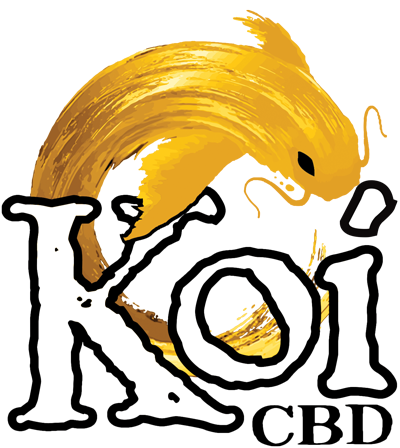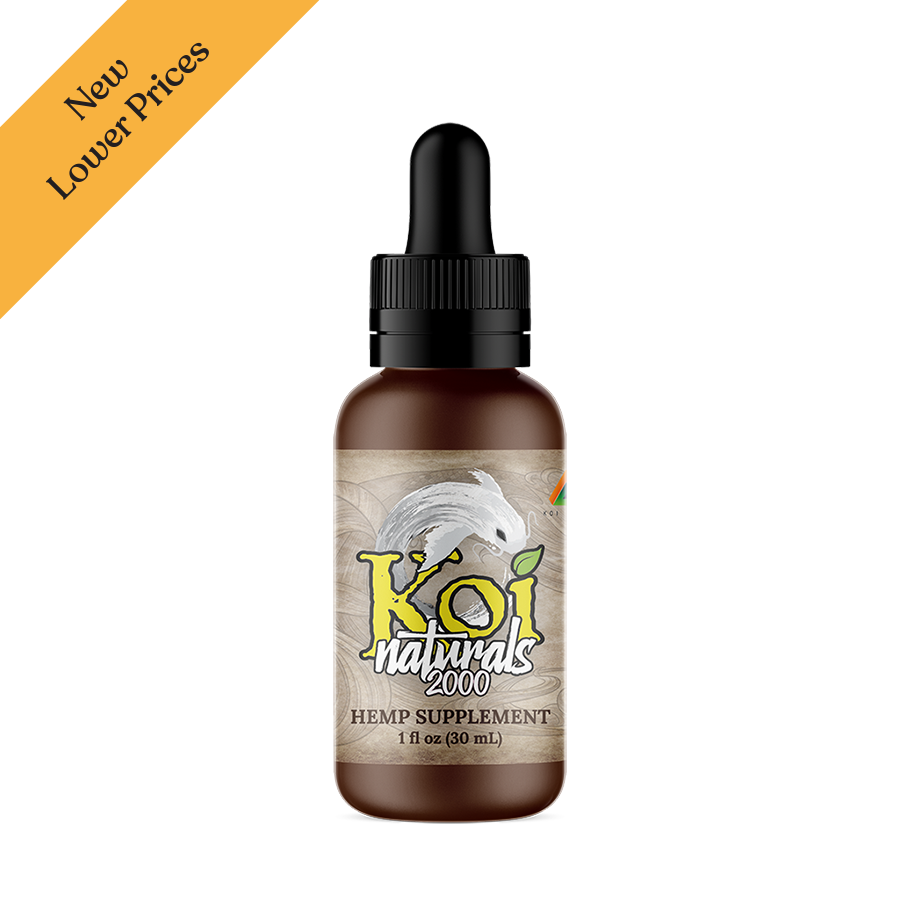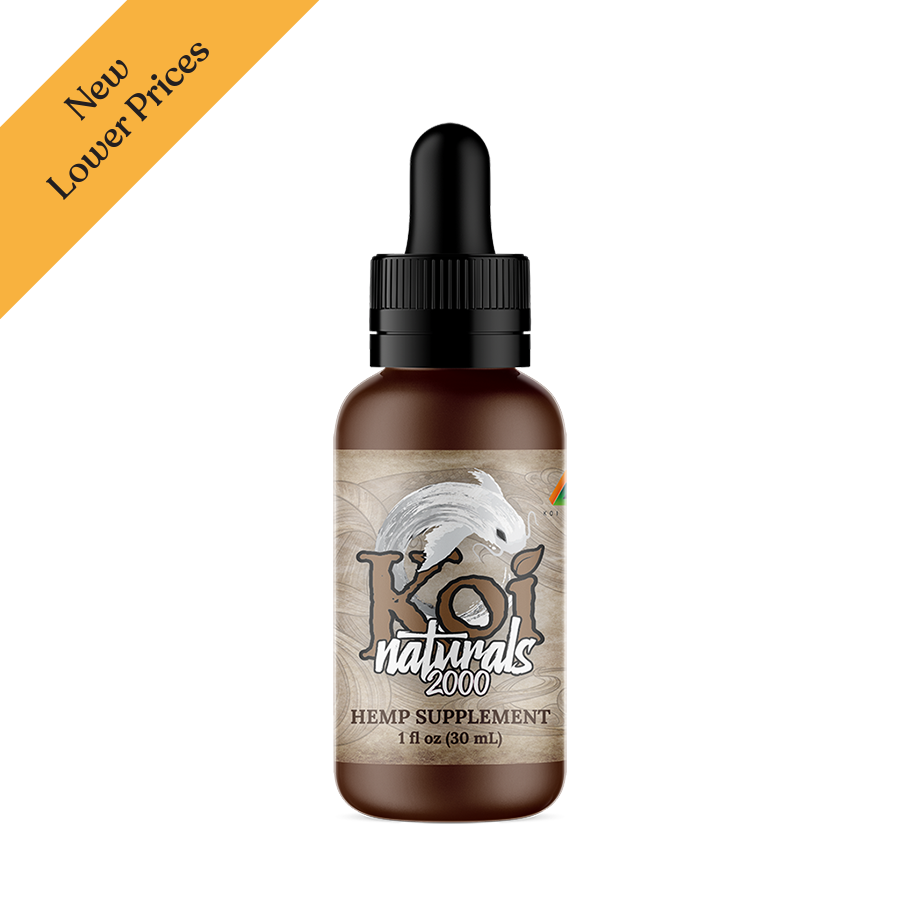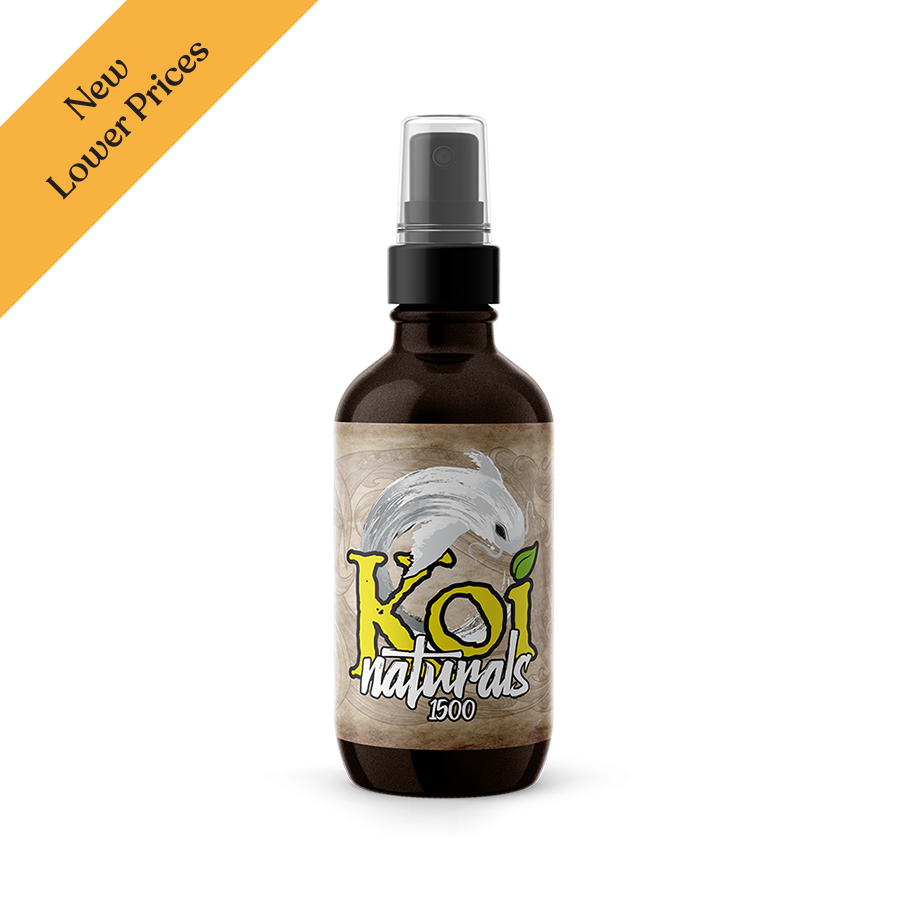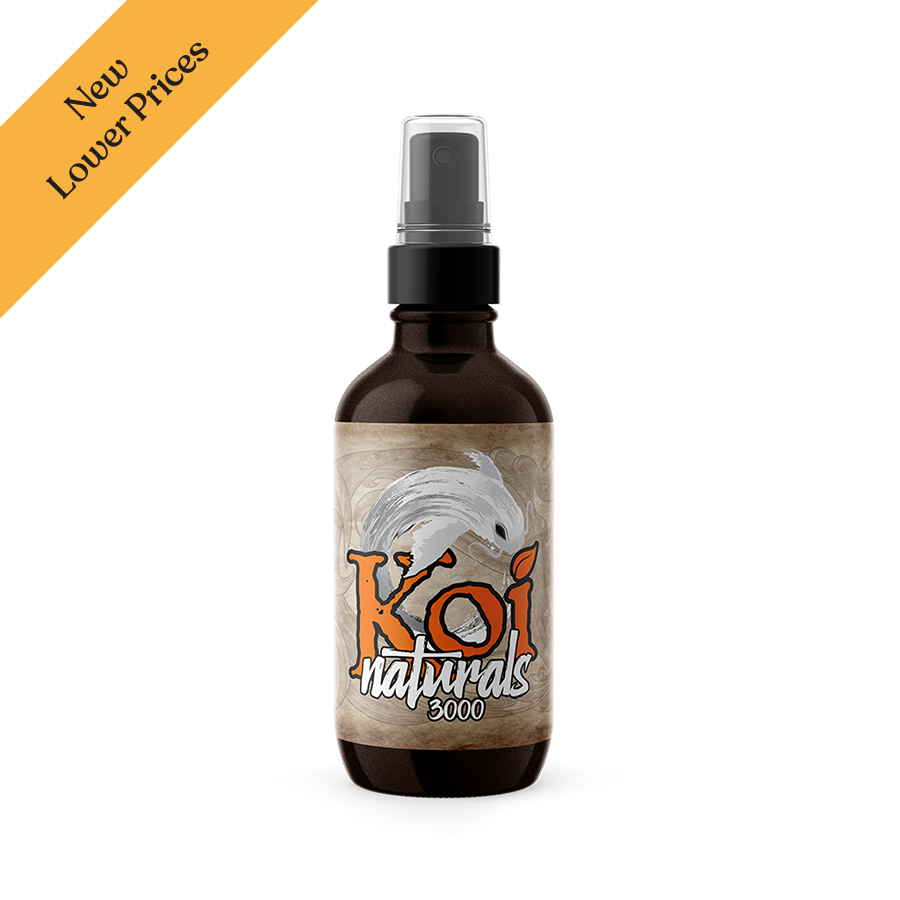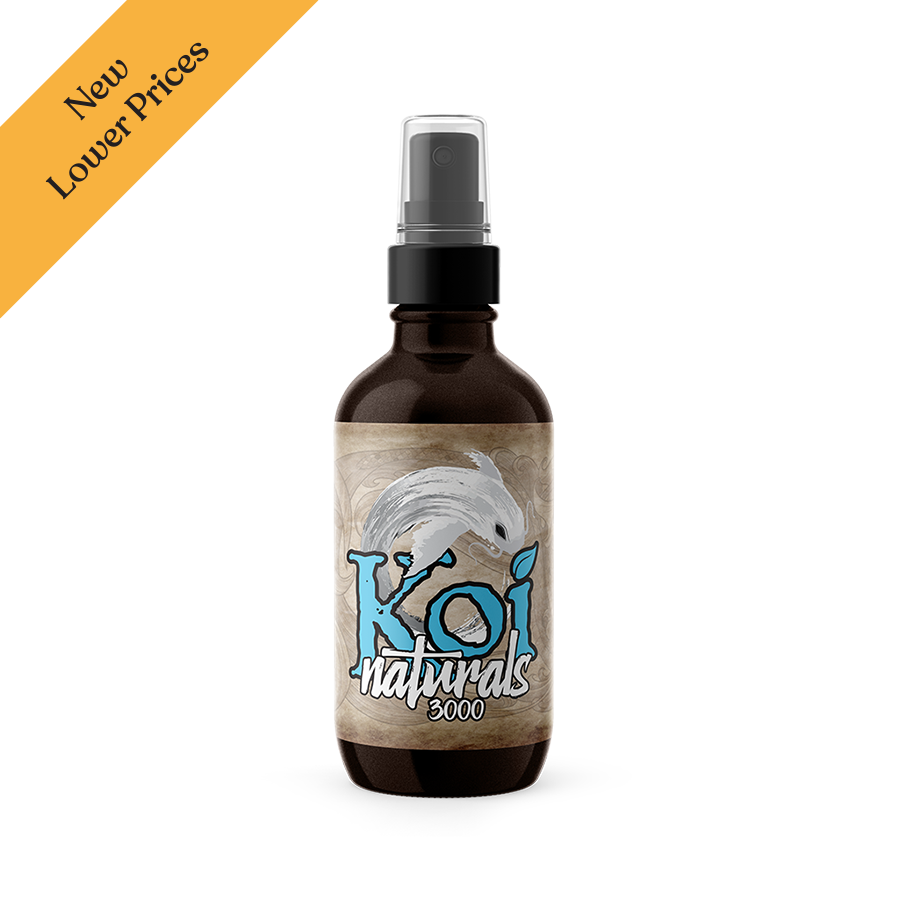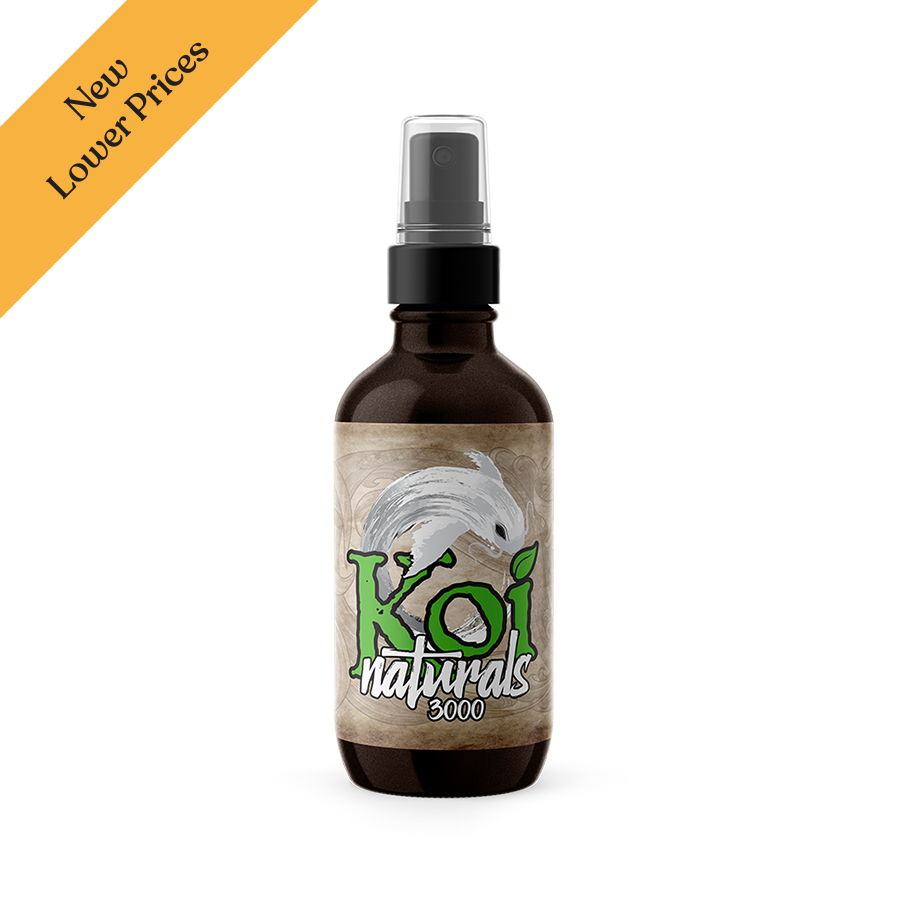Koi CBD
CBD Oil UK
The hype about CBD oil is real and growing. At Koi CBD, we have all the CBD information you need to know more about CBD and quality CBD oil products for both novices and experienced CBD users. Our full range of CBD products ensures you get quality results and enjoy the benefits of CBD oil without the worry of buying substandard products.
The popularity of CBD oil comes with a lot of myths and misconceptions. Your ultimate CBD oil experience should start with getting accurate CBD oil information to better understand the products and how they work.
What is CBD Oil?
CBD or Cannabidiol is one of the thousands of cannabinoids found in the Hemp plant, particularly the Cannabis Sativa L. plant. It’s a close cousin to the famed THC (Tetrahydrocannabinol).
Unlike THC, which is known to have psychoactive effects, CBD is non-psychoactive and carries many health and therapeutic benefits. Because CBD is a closely monitored substance, it is only collected from legitimate hemp plant varieties designed to have maximum CBD yield with minimal THC.
No CBD product should exceed the set maximum THC limit of 0.2% in the UK. This ensures the concentration of THC is not enough to trigger psychoactive effects or dependency on CBD lovers.
Benefits of CBD Oil
CBD offers various advantages for those who use it to manage multiple conditions or as a daily supplement.
All-natural
The greatest advantage of CBD oil is that it is 100% natural. The process of making and packaging CBD requires stringent measures to ensure the product doesn’t contain any chemical additives. What’s more, at Koi CBD, our CBD products are made from organically grown hemp, further increasing the benefits and reducing the side effects of CBD.
An extensive range of benefits
As noted above, CBD is credited with a variety of benefits, some of them medicinal and can also be used as an everyday supplement. As studies and research continue, it’s likely that these benefits will continue to increase.
Choose from various concentration options
We offer an extensive range of CBD concentration options to suit starters and experienced CBD users. The extensive range of CBD concentration options makes it easy to find the ideal CBD product to help manage your CBD condition or as a supplement.
We also have an extensive range of CBD products you can choose from. Each product is designed for users with a specific preference creating an excellent CBD experience.
Suitable for long-term use
You can use CBD for short-term and long-term use. Being a natural compound, it doesn’t harm the body or create dependency.
CBD Oil Disadvantages
Like every other product, there’s a downside to using CBD products. These include:
Products can be expensive
CBD products though competitively priced are more costly. This is because the process of growing the hemp plant and the extraction of CBD is intensive, complicated and expensive. This is more so the case for brands that take pride in the quality of their CBD products and produce them according to the FSA guidelines.
CBD has a bitter taste
It takes some time to get used to the taste of CBD. It has an earthy and bitter taste. At Koi CBD, we have remedied this by providing a variety of CBD products like CBD oil capsules that don’t have a smell or taste, making it easier to take CBD for users that don’t like the natural taste of CBD.
Your body might become CBD tolerant overtime
After using CBD for a long time, your body becomes tolerant and CBD isn’t as effective as it once was. Taking a short break from CBD helps restore the full benefits of CBD and ensure you can enjoy maximum results after that.
Some CBD brands are unreliable
With the hype that CBD has, some brands have taken this as an opportunity to make some fast cash. The result is substandard CBD brands made from low-quality hemp plants and containing too much THC. It’s essential to make sure you buy your CBD products from reputable and reliable brands for your safety and to enjoy the maximum benefits of CBD.
Hemp Oil VS CBD Oil
Hemp oil and CBD oil are sometimes used interchangeably by CBD lovers. However, the term Hemp oil is also more often used to refer to hemp seed oil.
Hemp seed oil and CBD oil are two different products obtained from the same plant. CBD oil is extracted from the stalks, flowers and leaves of the hemp plants. These parts of the plants have a high concentration of CBD.
Hemp seed oil, on the other hand, comes from the seeds of the Cannabis Sativa plant. The seeds do not contain CBD, but they have a broad profile of nutrients, bioactive compounds and fatty acids that also have health benefits.
Understanding the roles of both products is vital in helping you choose the best products for the intended purpose.
Hemp seed oil
Hemp seed oil has omega-6 and omega-3 fatty acids. It also contains gamma-linolenic acid, B-vitamins, Vitamin D and various nutritional antioxidants.
Like CBD oil, hemp seed oil does not get you high because it doesn’t contain tetrahydrocannabinol and contains trace to no amounts of CBD.
What is hemp oil used for?
Because hemp oil doesn’t contain CBD or THC, it is rarely used for recreational purposes. It is commonly used in the manufacturing of clothing and fibres and is widely featured in some supplements because of its high omega-6 and omega-3 content and other nutritional elements.
Effects and benefits
Hemp seed oil is often added to nutritional products like bread, snack bars, yoghurt, and cookies. When added to such products, it’s a source of unsaturated fatty and amino acids. It’s also credited for various benefits, which include:
- Relieving constipation
- Improving skin conditions
- It has cardiovascular health benefits
- Alleviating gastrointestinal conditions
How hemp seed oil is made
Hemp seed oil is extracted from the seeds of the hemp plant. The seeds undergo processing to extract the oil, which is then packaged for use.
CBD Oil Types
There are three different types of CBD oil in the market:
- Full-spectrum CBD – This type of CBD oil contains all the compounds of the cannabis plant. These include THC, but its concentration is restricted to below 0.2%.
- Broad-spectrum CBD oil – Broad-spectrum CBD oil contains most of the compounds of the hemp plant but doesn’t have any THC.
- CBD isolate – This is the purest form of CBD. It only contains CBD and nothing else.
When purchasing any CBD product, you should always check the Certificate of Analysis (CoA) conducted by third-party labs to understand the contents of your CBD oil products fully. Sometimes, the brands can use the above terms interchangeably. The CoA can help you determine the CBD product you’re purchasing.
Uses of CBD oil
The uses of CBD oil are broader than those of hemp seed oil. CBD oil is used as a daily supplement and also for its benefits and ability to manage specific conditions.
Research into CBD and its possible benefits is still ongoing. Although preliminary research is very promising, more research and studies need to be done to unearth the full potential and benefits of CBD.
Full-spectrum CBD products can be used for recreational purposes because they contain THC and it has psychoactive properties. But this is not effective since the presence of THC is limited but can have positive effects like preventing nausea. Full-spectrum CBD products also contain terpenoids and phytocannabinoids, which can further add to the benefits.
Full-spectrum CBD products that contain trace amounts of THC can also exhibit other benefits, which include anti-nausea and anti-inflammatory properties.
How is CBD oil made?
CBD oil is extracted from the hemp plant’s flowers, leaves and stalk. Manufacturers use special extraction processes like Carbon dioxide extraction to extract a liquid rich in CBD and other compounds found in the plant.
Once the liquid is extracted, manufacturers can decide the type of CBD products they want to make. For full-spectrum CBD oil products, the components of the liquids are kept intact. For CBD isolate, CBD is extracted from the liquid.
How CBD Works
CBD works by interacting with the brain and body through the Endocannabinoid System. The ECS is a complex biological system discovered in the early 1990s comprising of receptors and neurotransmitters tasked with maintaining homeostasis in the body. While little is still known about this system, researchers know that it impacts various major processes within the body, including mood, appetite, memory and sleep.
Components of the ECS
The endocannabinoid system has three main components. Each of them plays a crucial role in the processing and uptake of CBD and other cannabinoids.
Receptors
The first component of the ECS is the receptors. These exist within the body as a substance to which the endocannabinoids bind.
There are two types of receptors: CB1 and CB2. CB1 receptors are found in the central nervous system and manage coordination, appetite, pain, movement, mood and memory, among other integral functions.
CB2 receptors are found in the peripheral nervous system and influence pain perception and inflammation.
Enzymes
The second component of the ECS system is the enzymes. The enzymes appear in many forms, but only two types are capable of breaking down endocannabinoids.
The endocannabinoids are received at the receptors where the enzymes break them down and then have them absorbed into the body to impact various effects.
Endocannabinoids
Endocannabinoids form the final part of the ECS. These are molecules similar to CBD made by the body and work to modulate the ECS. It is these endocannabinoids that are received by the ECS receptors and broken down by the enzymes.
CBD and non-cannabinoid receptors
Although the CB1 and CB2 receptors are designed to bind to endocannabinoids, THC and some cannabinoids like CBD are slightly different and far more complicated. It has little binding affinity for either of the cannabinoid receptors. However, through the ECS, CBD blocks the breakdown of endocannabinoids allowing it to use what is already being produced naturally.
It is also known to work through various non-cannabinoid receptors and ion channels to achieve multiple effects. Some of the non-cannabinoid receptors that CBD interacts with include:
Serotonin receptors
In high doses, CBD interacts directly with the 5-HT1A serotonin receptor to curb anxiety. This receptor is used in various applications, common among them addiction, perception of pain, nausea, appetite, sleep and vomiting. These receptors are found in the central nervous and peripheral nervous systems.
Vanilloid receptors
The TRPV1 receptors mediate pain, body temperature and inflammation. CBD interacts with the various ion channel to exert its therapeutic effects.
The Transient Receptor Potential Cation channel subfamily V as it is also known is one of the several dozen TRPV receptor variants that help to transfer the effects of most medicinal herbs. This receptor is also referred to as the Vanilloid receptor.
When CBD binds to this receptor, it influences the perception of pain. This is the same receptor activated by capsaicin, the active compound in chilli peppers.
Orphan receptors (GPR55)
CBD doesn’t directly activate the GPR55 receptors. Instead, it acts as an antagonist, blocking, or deactivating the G-protein receptor.
The receptor is widely present in the brain, particularly in the cerebellum and is involved in modulating blood pressure and bone density, among other processes. By blocking the GPR55 signals, CBD can help to decrease bone reabsorption and also curb the spread of cancer cells.
PPARS (Nuclear receptors)
CBD can also confer its anti-cancer effects through the Peroxisome Proliferator-Activated Receptors (PPARS) found on the surface of the nucleus. The activation of these receptors results in an anti-proliferation effect and can also help to induce tumour regression in lung cancer. It also degrades the amyloid-beta plaque, a crucial molecule that leads to the development of Alzheimer’s disease, explaining how CBD helps manage the condition.
PPAR receptors also regulate other crucial functions like lipid uptake, insulin sensitivity and energy homeostasis, among other metabolic processes indicating that people with diabetes can benefit from CBD treatment.
An allosteric modulator
CBD can also work as an allosteric modulator meaning it can enhance or inhibit how receptors transmit a signal by altering the shape of the receptors. The GABA-A receptor is one of the receptors that CBD imposes its will. Researchers believe CBD is able to reduce anxiety by changing the shape of the GABA-A receptor to amplify the natural calming effect of gamma-aminobutyric acid (GABA).
These are the different ways in which CBD is thought to work inside the body to achieve different results. Studies are still underway to find more ways CBD interacts with the body, the different non-cannabinoid receptors, and the ECS and unearth more benefits.
How to Take CBD Oil?
As time passes and the interest in CBD grows, Koi CBD works hard to come up with CBD products that are easy to take. We understand that not all CBD lovers would like one product, so we have different options and that means there are various ways of taking CBD.
Orally
Oral ingestion is one of the easiest and most fun ways of taking CBD. Some of the CBD products that can be taken orally include capsules and CBD edibles. You can also take CBD oil tinctures orally if you add the oil to your food or drink.
Most CBD users opting to take CBD orally don’t like the taste of CBD. That is why we offer a range of quality, great-tasting products that make taking CBD easy.
You can find CBD oral products in full-spectrum, CBD isolates and broad-spectrum forms and most of them are easy to dose.
Pros of taking CBD orally
- You can choose from various CBD consumption methods depending on the oral products you choose.
- It is easy, fun and diverse. You can even create your own CBD edibles.
- Some of the oral CBD products, like gummies, are very discrete because you’re just eating something that appears normal to those around you.
Cons of taking CBD orally
- The effects long to kick in (sometimes up to four hours).
- Because the CBD goes through the digestion process where some of it is lost, getting the right dose can be tricky and requires some experimenting.
Sublingually
Taking CBD sublingually yields faster results than taking it orally. When taking CBD oil sublingually, a few drops of the compound are placed under the tongue and held in place for a few minutes. The buccal cavity is concentrated with capillaries, which absorb CBD and transport it around the body.
CBD oil tinctures are designed for CBD lovers who want to take CBD sublingually. This method is ideal for those that don’t mind the taste of CBD and also want to take CBD in high doses and experience faster effects. This is also a great way to add many cannabinoids to your daily intake.
Pros of taking CBD sublingually
- You don’t need any accessories or extra tools to take CBD sublingually and it’s easy to use.
- You can use it in public without drawing attention to yourself.
- Since you’re taking drops, it’s easy to calculate and track how much CBD you take through this method.
- The effects are more potent and longer-lasting when CBD is taken this way.
Cons of taking CBD sublingually
- The results vary from person to person
- It’s not the fastest method of delivering CBD to your system, but it is faster than taking CBD orally.
- Some of the CBD tinctures contain alcohol. Please check the ingredients if you’re trying to avoid alcohol.
Topicals
Topical CBD products are applied directly to the skin. They comprise of CBD-infused lotions, creams, transdermal patches, balms, salves, and the newest addition to this collection, CBD bath bombs.
CBD topicals are an excellent choice when treating skin conditions like acne or localised pain and inflammation. This is one of the simplest methods of using CBD. It doesn’t require any special tools or knowledge of use. You just need to know the dosage then apply a corresponding amount.
You can use CBD topical products for sore muscles, sore joints and also for skin conditions like eczema. You can apply the product directly to the affected areas and for migraines, you can apply it to the temples.
Pros of topical CBD application
- It is easy to use.
- Works perfectly for sore muscles and chronic pain.
- You don’t need any extra tools or accessories.
- The effects are mild, making it perfect for beginners.
- The effects happen quickly.
Cons of topical CBD application
- The skin is highly impermeable. You might need to use high concentration CBD products.
- The effects are mild, which might not work for experienced CBD users or severe symptoms.
- The effects don’t last as long compared to other methods.
Smoking
Smoking CBD is not popular, but it is possible by smoking CBD concentrate using an oil rig that looks like a water pipe. The tool has a heating “nail” that heats up and then you place CBD oil onto the nail with a dabber, which produces the smoke you inhale.
In some cases, CBD users who also prefer to use marijuana can also roll it into a joint using dry high-CBD content hemp. Because the THC content, in this case, is not controlled, you will experience some psychoactive effects.
Pros of smoking CBD oil
- The highest concentration of CBD is delivered in the fastest way.
- You can easily manage how much CBD you consume.
Cons of smoking CBD oil
- Smoking has a harsh feeling on the throat and lungs.
- The high concentration of CBD delivered in a short time can be more than what some people want.
- You need additional tools like a dabber and an oil rig.
- It’s not a discreet method of taking CBD oil.
Vaping
Vaping is a relatively new and safer alternative to smoking CBD oil. Vaping requires you to have a vapouriser pen and is preferred because CBD oil vaping products are regulated, meaning you don’t need to worry about consuming more than the recommended levels of THC. It’s also not harsh on your throat or lungs.
Pros of vaping CBD
- Vaping delivers a high concentration of CBD for maximum effects.
- There’s no harsh smoke to irritate your lungs and throat.
- You can easily control your dosage amounts.
- Vaping tools are highly adjustable, allowing for a customised experience.
Cons of vaping CBD
- The high concentration of CBD might be a little too much, especially for beginners.
- You need extra tools like the vape pen and its accompanying accessories.
- The extra accessories you need can be costly.
These are the four main ways to take CBD oil. Under each method, you have various CBD oil products to choose from to ensure you enjoy the best possible CBD experience.
What to Look for When Buying CBD Oil?
There are hundreds of CBD brands in the market and there are new ones coming up every day. Some of them are genuine, while others are looking to make quick money by selling substandard CBD products that could compromise your health.
Knowing what to look for when buying CBD products can reduce the chances of buying low-quality products and prevent undesirable side effects.
The label
The label of the product says a lot about it and the manufacturer. It should have a list of ingredients that you can clearly see and it should also have a disclaimer since it is a dietary supplement.
It should be third-party tested
The only way you can be sure about the contents of the CBD products you buy is by getting access to the third-party lab test results. Third-party lab results confirm the accuracy of the label and also confirm the dose of the product. You can find the lab results on the retailer’s website. Some brands will even include a printed version in the packaging.
CBD concentration
Every CBD product should have the dose clearly indicated. If a product doesn’t have the CBD concentration clearly indicated, it’s best to pass. Although CBD concentration is not a matter of quality, it determines if your CBD product is ideal for the intended purpose.
Is there a batch number?
All CBD products should have a batch number. It shows the manufacturer is following good manufacturing practices and can identify their products in case of a need to recall.
Are there additional ingredients?
A lot of manufacturers claim to have all-natural, organic CBD products. But a quick look at the ingredients list confirms various artificial ingredients are added to the products. It’s important to know everything you’re ingesting. In some cases, manufacturers can add ingredients like alcohol to tinctures to improve uptake and other ingredients like melatonin.
How Much CBD Oil Should I Take?
The secret to enjoying maximum CBD benefits lies in finding the ideal dose depending on several factors. Unfortunately, there’s no way of identifying the ideal dosage, so in most cases, you have to calculate or increase the dose in intervals until you hit the sweet spot.
Estimate your CBD dose based on your body weight
Individuals with more body mass require more CBD to experience the same level of effects as those with a low body mass. The best approach to determine your CBD dose, in this case, is to take 1 – 6 mg of CBD for every 4 – 5 KGs of body weight.
The concentration of CBD to use depends on the severity of the condition or symptoms you’re managing. For mild symptoms, you can use 1 – 3 mg of CBD. For average use, 2 – 4 mg is ideal and for severe symptoms, you can use 4 – 6 mg of CBD for every 4 – 5KGs of body mass.
Start small and work your way up
If you find the calculation method too tedious, you can start small and keep increasing until you feel the desired effects. This is the most commonly used method when trying to determine how much CBD you should take.
Using this method, you can start with a base concentration of CBD and take it for a couple of days as you observe how your body responds. If you find the effects are not sufficient, you can increase the dose. Alternatively, you can maintain the dose but increase the number of times you take your CBD.
It’s important to give your body some time to adjust to the new dose before adjusting it. You could save some time by determining the initial dosage based on your weight then adjust from there.
Consult a physician
Consulting a physician before using CBD oil for medical reasons is always highly recommended. This is more so the case when you’re already taking other pharmaceutical drugs to prevent interactions, or you have special conditions.
If you’re in doubt about the amount of CBD oil you should take, you should also consult your doctor. Most doctors don’t have much experience with CBD, but they have a good idea of how your body will respond and provide professional advice on the ideal CBD dosage for you and your situation.
It’s important to note that the ideal dosage for CBD products depends on various other factors, not just the weight and symptoms. Your rate of metabolism, the mode of taking CBD and the concentration of the CBD product you choose will all determine the ideal dose for you and the effects to expect.
Forms of CBD Oil
CBD oil is one of the premier CBD products on the market and remains one of the most popular and sought-after. You can find CBD oil in multiple products making it easy for CBD enthusiasts to find products that best appeal to their preferences and make it easy to consume CBD oil.
Tinctures
CBD tinctures are a blend of CBD oil mixed with base oil. They come in a dropper bottle for easy administration. Tinctures are often preferred because of their easy administration and come in a wide range of CBD concentrations. Naturally, CBD tinctures have a bitter, earthy taste that some people have difficulty withstanding. However, manufacturers have added natural flavours to the tinctures to make them easier to take.
Another advantage of CBD tinctures is their diversity. You can add CBD oil in tinctures to your food and drinks. You can also take the tincture orally or sublingually, depending on how fast you want to feel the effects.
Capsules
CBD capsules are a better way to take CBD oil for those that can’t stand the natural taste of CBD oil. The capsules have the CBD oil enclosed in gelatine, a soft gel case that is easy to swallow and has a pre-measured amount of CBD oil locked inside the soft gel.
Capsules are an ideal option for new CBD fans that still haven’t figured out how to measure the perfect amount of CBD to consume using the dropper on the CBD tincture. Because the CBD oil is pre-measured, you don’t have to worry about manually measuring the amount of CBD. Just take your CBD capsule on the go. The CBD oil in capsules is not flavoured, but you also don’t have to worry about the flavour since it is enclosed and is only released in the stomach once the gelatine casing is broken down.
Sprays
One of the downsides of using a CBD tincture dropper is that the scope of application is limited to where the drops land, significantly reducing absorption. CBD oil sprays aim to solve this problem by widening the scope of application.
Essentially, sprays and CBD tinctures are the same product. Only the applicator is different. Instead of a dropper, the applicator on the sprays is a sprayer. Most of the other features, including concentration and flavour, are similar in both products. However, because CBD oil lands on more parts of the mouth, the absorption rate is better with CBD oil sprays.
What you choose mainly comes down to your preference and the effects you hope to get. For instance, with CBD tinctures and sprayers, you can get faster effects when you take the CBD oil sublingually. In contrast, you can only take capsules orally, which delays the onset of effects because the capsule must be digested.
How to Get the Most from CBD Oil
Although CBD oil is effective, there are ways you can increase its bioavailability in the body and give yourself the best chances of making the most out of every drop of CBD oil you consume.
Full-spectrum or broad spectrum CBD
Start by finding the most potent type of CBD Oil on the market. These are full-spectrum and broad-spectrum CBD oils. Even with the same CBD concentration, these varieties have more potent effects because of their composition, which includes other cannabinoids, terpenes and flavonoids.
Get the right CBD concentration
The strength of the effects you feel depends on the CBD concentration of your CBD oil. Lucky for you, CBD oils come in a wide range of concentrations. If you’ve been taking CBD oil but not feeling the effects, consider buying an option with a higher CBD concentration or increasing the amount of CBD you take.
Take a fatty meal before taking your CBD
One of the reasons CBD oils have a carrier oil is because the oil helps to increase the absorption rate of the CBD. You can compound this effect further by taking fatty foods like avocados before taking the CBD oil, especially when you take CBD orally. This will help with absorption and bioavailability for better effects.
Take your CBD at the same time every day
Consistency is vital when taking CBD oil, especially when you want to have predictable results and want to monitor the effects. Ensure you take your CBD oil around the same time each day. It will make it easier to know when the effects kick in, how long they last and whether you should adjust your CBD oil intake.
When is the Best Time to Take CBD Oil?
There’s no better time to take CBD oil than the other per se, mainly because CBD oils have different formulations designed to deliver different effects. That means you can choose your CBD oil depending on the impact you want to feel. There are CBD oil types designed to make you feel energetic, alert and focused which are perfect for taking in the morning when you want to give yourself the best start to the day.
There are also options designed to deliver relaxing and calming effects, which are best taken in the evening after a hard day when you want to unwind and prepare for a restful night. With that in mind, the best time to take CBD oil differs depending on the type of CBD oil you purchase and the effects you want to experience.
Potential Side Effects
CBD oil is well-tolerated among most CBD connoisseurs. It has low toxicity and is mainly safe, especially when you purchase genuine CBD oil from reputable and responsible manufacturers. There have been some mild and temporary side effects reported in some rare cases, which include:
- Dry mouth
- Nausea
- Itchiness
- Vomiting
- Diarrhoea
Most of these reports have been from new CBD fans who’ve experienced the effects because of taking too much CBD oil before building enough tolerance for it. Should you experience such side effects, we recommend you lower your CBD intake.
You can also experience adverse side effects after taking CBD oil if you purchase substandard CBD products with poor-quality ingredients. Some of the ingredients added to CBD oil and the hemp plants used might contain contaminants that might harm your health. Always ensure you purchase CBD oil where the third-party certificates of analysis are readily available.
CBD Oil FAQs
Is CBD oil safe?
Yes, CBD oil is safe. There have been numerous studies on both human and animal subjects, and none have found CBD unsafe. Ensuring you buy quality CBD products from a reputable supplier is vital because substandard CBD products can have undesirable effects because of poor sourcing and additional artificial additives.
Is CBD oil legal in the UK?
There are no laws in the UK prohibiting the sale and purchase of CBD products. However, for the sake of safety, there are laws that govern certain aspects of the production of CBD, among them the concentration of THC that legal CBD products should have. In the UK, THC concentration in CBD products is capped at 0.2%.
What is CBD oil good for?
CBD oil is suitable for a variety of things. It helps in pain relief, fighting inflammation, you can use it for various skin conditions like eczema and acne and for fitness buffs. It makes an excellent salve to relieve muscle and joint soreness.
CBD manufacturers are also leveraging its calming effects and using it to make CBD bath bombs to help with relaxing and calming down after a busy day at work. It can help with back pain, arthritis pain, improve sleep, and various other conditions.
How many drops of CBD oil should I take?
The number of drops you should take depends on your dosage. Ideally, the dropper used in tinctures holds 1ml of liquid. If you have a 30ml CBD tincture containing 1500mg of CBD, that means you will have 50mg per dropper.
If your dose is 50mg, then you need to take the whole dropper. If your dose is 25mg, you only need to fill the dropper halfway.
How long does it take for CBD oil to work?
That depends on the method you use to take CBD. Some methods like vaping CBD have immediate results, while others like taking it orally could take up to 4 hours for the CBD to work. Applying it topically or sublingually also helps in faster delivery of CBD and quick action.
What’s the difference between full-spectrum CBD oil and broad-spectrum?
Full-spectrum CBD contains all the cannabinoids, terpenes and some THC found in the hemp plant. Broad-spectrum has the same composition, but it contains zero THC, making it an ideal option for CBD lovers that want the entourage effect without taking any THC.
Is It Possible to Take Too Much CBD?
CBD has very low toxicity. Although it is possible to take too much CBD for your system, it’s unlikely that your body or life is at risk unless you make taking absurd doses of CBD a habit. CBD has low toxicity, but while your life might not be in danger, you might experience some undesirable effects like lethargy, extreme drowsiness, diarrhoea and an upset stomach, among other side effects.
Part of understanding how much CBD to take is to ensure your body adjusts to the new product in your body and limit the potential of experiencing some of the mentioned side effects.
What are the side effects of CBD oil?
CBD is often well-tolerated. It’s uncommon for CBD users to report any side effects. However, it can cause mild side effects like a dry mouth, reduce appetite, drowsiness, fatigue and diarrhoea among first-time users or when taken in substantial amounts.
Will CBD oil get me high?
Although CBD and THC are close cousins, CBD doesn’t have psychoactive effects and will not get you high. Even for CBD products made from full-spectrum CBD, the THC content is minimal and will not make you high.
Does CBD show up on a drug test?
Most first-time CBD users are concerned about using CBD because of an upcoming drug test. Drug tests often test for THC and not CBD. As such, CBD would not result in a positive drug test. Even for CBD products that contain THC, it needs to meet a certain threshold to trigger a positive result. In CBD, the concentration of THC is too low and doesn’t meet the threshold to turn a positive test.
Can I give CBD to my pet?
Once you discover CBD is effective for you, you might be tempted to give it to your pet, especially when they are going through a condition or recovering from an injury. Generally, CBD products are safe. But it’s best to buy CBD products designed for pets and always make sure you purchase quality CBD products even for your pet.
